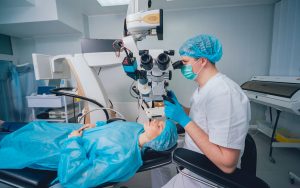In today’s world, where technology is advancing at a rapid pace, it is no surprise that even vision correction methods have evolved. RLE is a revolutionary procedure that has gained popularity in recent years due to its ability to enhance vision beyond traditional methods. Let’s delve deeper into what RLE is and how it can benefit those struggling with vision problems.
What is RLE?
Refractive Lens Exchange (RLE) is a surgical procedure that involves removing the natural lens of the eye and replacing it with an artificial intraocular lens (IOL). This procedure is similar to cataract surgery, where the cloudy lens is replaced with a clear one. However, in RLE, the natural lens is replaced with an IOL that is specifically chosen to correct the patient’s vision.
Benefits of RLE:
- Corrects a wide range of vision problems: RLE can correct a variety of vision problems, including nearsightedness, farsightedness, and astigmatism. It is also an excellent option for those with presbyopia, a condition that affects the ability to see up close as we age.
- Long-lasting results: Unlike other vision correction methods, RLE provides long-lasting results. The artificial lens does not age or change over time, so the patient can enjoy clear vision for years to come.
- Eliminates the need for glasses or contact lenses: RLE can significantly reduce or eliminate the need for glasses or contact lenses. This is especially beneficial for those who have been dependent on corrective eyewear for most of their lives.
- Quick recovery time: The recovery time for RLE is relatively quick, with most patients experiencing improved vision within a few days. This is because the procedure is minimally invasive and does not require any stitches.
The Procedure:
Before the procedure, the patient will undergo a thorough eye examination to determine the best IOL for their vision needs. On the day of the surgery, the patient will be given local anesthesia to numb the eye and a sedative to help them relax.
The surgeon will then make a small incision in the cornea and use a specialized instrument to break up and remove the natural lens. The IOL is then inserted through the same incision and placed in the correct position. The incision is self-sealing, so no stitches are required.
Risks and Complications:
As with any surgical procedure, there are some risks and potential complications associated with RLE. These may include infection, bleeding, and inflammation. However, these risks are minimal, and most patients experience a smooth and successful recovery.
Conclusion:
Refractive Lens Exchange (RLE) is a safe and effective procedure that can enhance vision beyond traditional methods. It offers a long-lasting solution for a wide range of vision problems and can significantly improve the quality of life for those struggling with vision impairment. If you are considering RLE, consult with a qualified ophthalmologist to determine if it is the right option for you.
Frequently Asked Questions:
How much does RLE cost?
The cost of RLE can vary depending on the type of IOL chosen and the location of the surgery.
Can both eyes be done at the same time?
Yes, it is possible to have both eyes done at the same time. However, some surgeons may recommend doing one eye at a time to ensure proper healing and minimize the risk of complications.
Are there any restrictions after RLE?
Patients are advised to avoid strenuous activities and heavy lifting for a few weeks after the procedure. They should also avoid rubbing or putting pressure on the eye and follow the prescribed eye drop regimen.
Can RLE be reversed?
No, the RLE cannot be reversed. Once the natural lens is removed, it cannot be put back. However, if the patient experiences any issues with the IOL, it can be replaced with a different one.
How often do I need to follow up with my surgeon after RLE?
Your surgeon will schedule follow-up appointments to monitor your healing and ensure that your vision is improving as expected. It is essential to attend these appointments and follow any post-operative instructions given by your surgeon for the best results.
How soon can I resume my daily activities after RLE?
Most patients can resume their daily activities, including driving, within a few days after the procedure.
Is RLE painful?
The procedure is painless as the eye is numbed with local anesthesia. Some patients may experience mild discomfort or pressure during the surgery, but this is temporary.
Who is a suitable candidate for RLE?
RLE is suitable for individuals over the age of 40 who have a stable prescription and are not suitable candidates for LASIK or other laser vision correction procedures.
Is RLE covered by insurance?
RLE is typically not covered by insurance, as it is considered an elective procedure. However, some insurance plans may cover a portion of the cost if the patient has a medical condition that affects their vision.
How long does the procedure take?
The RLE procedure typically takes about 15-20 minutes per eye.




